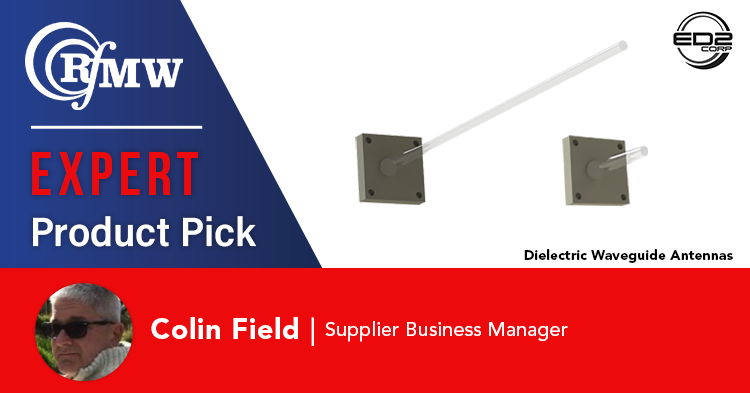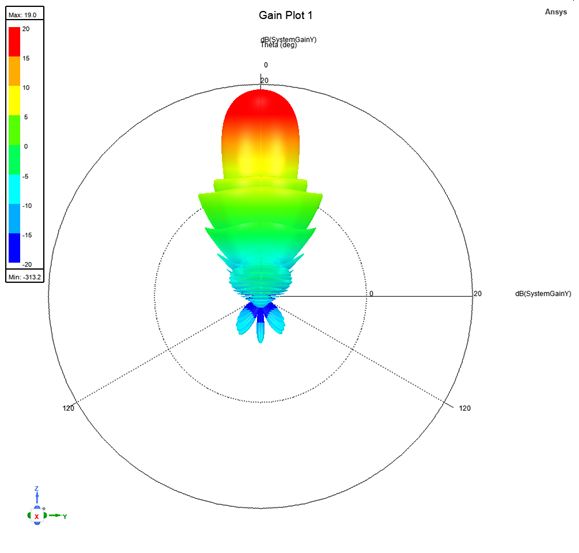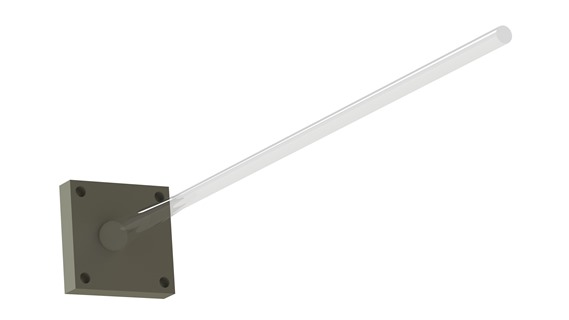
ED2 Corporation has developed a technology that offers an alternative to electronically steerable antenna arrays that are commonly used in millimeter band 5G applications from base stations to small cells to phones. Depending on the application, a phased array antenna may not offer the system designer optimum performance in terms of efficiency, power consumption and user experience when compared to other antenna solutions available on the market.
ED2’s Dielectric Waveguide Antenna (DWA) offers advantages over electronically steerable arrays in that a single DWA can replace a whole array or sub array comprising dozens of electronically steerable patch antennas resulting in lower cost, power consumption and more consistent beam characteristics, such as symmetric antenna patterns, back lobe suppression and zero scan loss. The gain and radiation pattern (Figure 1) of ED2’s DWA demonstrates its high gain, exceptional beam directionality, and minimal backscatter.

Figure 1: The ED2-0011-01000 dielectric waveguide antenna has high gain and excellent directionality.
Source: ED2 Corporation
The ED2-0011-040200 DWA exhibits excellent temperature characteristics, remaining highly stable with temperature over the -55 to 125 degree operating range. It is flexible in design, offering dual linear polarized inputs and high antenna gain (EG 19.5dB at 28GHz) with greater than 20dB cross polarization isolation. Its small form factor (22.35 x 22.35 mm) and SMPM connectors make it an ideal plug and go solution with no need for calibration. ED2 DWA solutions present an alternative approach to phased arrays for use cases involving moderately narrow beamwidths, pedestrian speeds, or fixed wireless access applications.
ED2’s disruptive antenna technology is based on dielectric waveguides that travel along a medium, traditionally known as a polyrod. Originally developed by Bell Labs in the 1940’s, the “polyrod” (Figure 2) antenna utilizes a phenomenon of irregularities on the surface of a rod that causes radiation of a signal propagating along the rod. The solution is a low cost, highly efficient, simplified antenna for fixed and low mobility 5G networks.

Figure 2: A polyrod directional antenna using dielectric waveguide
Source: ED2 Corporation
The deployment of millimeter waves in 5G applications is challenging when compared to Sub 6GHz deployment. The issues of high signal attenuation, line of sight transmission and rain fade make millimeter wave technology in high mobility use cases difficult to justify due to the complexity of system design required.
Electronically scanned phased arrays include many, sometimes hundreds, of antenna elements that individually require phase shifters and PA’s. Additionally, power and electronics are required to control each phase shifter and PA. The amount of incorporated components can lead densely packed panels that present challenges of alignment, thermal management, power consumption, and cost.
Supporting MIMO can also be challenging for an electronically scanned phased array as each MIMO steam needs to be configured to a specific sub array. As more user equipment (UE ) is introduced, the size of sub array per UE reduces, resulting in wider beamwidths and lower antenna gain. The software that is required to operate and coordinate electronically phased array antennas is also exceedingly complex, presenting integration difficulties for solution designers.
While an electronically scanned phased array has advantages when operating in a high mobility environment, the low mobility nature of current and proposed global deployments suggest that a simpler approach to antenna design may bring substantial benefits to system engineers. Antenna design considerations for low mobility 5G millimeter wave applications include high efficiency, low heat dissipation, nano second beam activation and switching, dual polarization, and consistent beam gain and width irrespective of UE location. The system must also support MIMO operation and multi lobe beamforming.
In conclusion, ED2’s DWA is an optimal alternative solution for phased arrays in use cases requiring specific beamwidths, pedestrian speeds, and fixed wireless applications. ED2’s DWA offers design flexibility, cost efficiency, and low power consumption. The ED2-0011-040200 DWA is an ideal plug and go solution with dual polarization isolation and high gain. If your design is seeking a compact antenna solution that eliminates the need whole or sub arrays of patched antennas, ED2’s DWA is an optimal component.
About the Author:
Colin Field is an RFMW Supplier Manager responsible for passive components with a particular focus on RF Filters and antenna solutions. Beginning his carreer in 1984, Colin has a passion for physics which has led to a lifelong interest in materials technology, properties and the potential uses and applications of those materials. |
